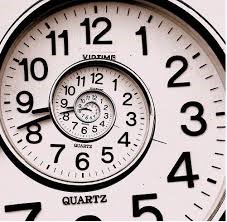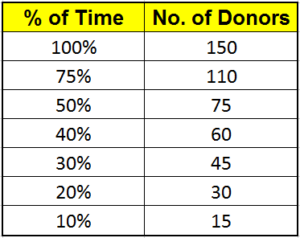 Earlier this month I wrote a blog post called “I Don’t Have Time for Major Gifts.” Since then, I’ve heard from quite a number of people telling me they really do value major gifts, but they’re not sure how to actually make time for it.
Earlier this month I wrote a blog post called “I Don’t Have Time for Major Gifts.” Since then, I’ve heard from quite a number of people telling me they really do value major gifts, but they’re not sure how to actually make time for it.
Many who are asking this question are from small or medium-sized organizations who don’t have a major gift officer and are wearing multiple “fundraising hats.”
So here’s a guide to help you figure out how to “do” major gifts and start developing authentic relationships with your qualified donors.
Step 1: Figure out (and commit to) the percentage of your time that you’ll devote to developing your portfolio of qualified major donors.
Step 2: Use this simple chart below to figure out how many qualified donors you can work with successfully, given the percentage of time you are committed to:

Step 3: Qualify your pool of potential donors (see our white paper on how to do this). You can’t successfully cultivate your portfolio without qualifying your donors. You’ll need at least 3 donors that meet your major gift metric (e.g. $1,000 cumulative giving in the last 12 months) to get one donor to qualify.
Step 4: Tier your donors – A, B, and C level. Regardless of how many qualified donors you have in your portfolio, you need to tier your donors to help you focus your time correctly on your higher value donors.
Step 5: Create a revenue goal and a strategic plan for every qualified donor in your portfolio over the next 12 months. This is crucial. This plan will be your guide to know what to do with each of your donors and when. It will help you to focus. Because you may be working on so many different fundraising activities, it’s extra important you do this.
Step 6: Build in accountability. I guarantee you – this will NOT work if you don’t have someone to meet with on a consistent basis to make sure you’re staying on track with your donors. In fact, all the other steps will be useless for you IF you don’t have this in place. You may say, “hey I don’t need someone looking over my shoulder to do this work,” but you would be wrong. You need this in place.
Step 7: Work your plan – do what you said you were going to do. IF you do that, you’ll see relationships built with your donors and start seeing success.
Even if you can only commit to 10% of your time and only work with 15 donors – that’s GREAT! But as Richard and I know very well, you have to stick to your commitment. It’s extremely easy to lose your focus if major gift fundraising is just one part of your overall fundraising responsibility.
Use these seven steps as your guide for how to make time for major gifts at your organization.
Jeff
PS — Please take advantage of all the free white papers highlighted here. They’ll make your job so much easier.
Search Blog Posts







0 Comments